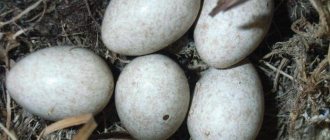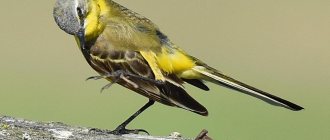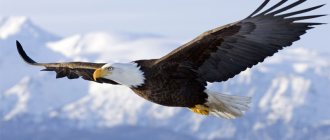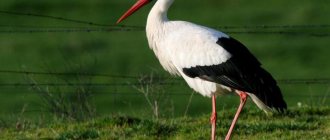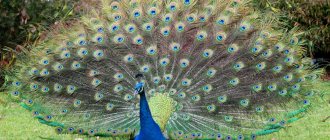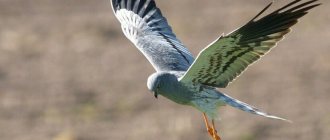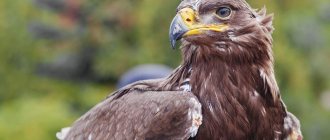Habitat
The only place where this unique bird of prey lives is the Philippine Islands. It was first discovered in 1896 on the island of Samar by the English ornithologist D. Whitehead. The population of Philippine eagles has been steadily declining and can currently only be found on 3-4 of the archipelago's more than 7,000 islands. The last bird on the island. Samar, where it was first seen, was seen in 1933. In the last century, about a dozen eagles were on the neighboring island of Leyte; they were also found on the island. Luzon.
The largest number, approximately 1,200 individuals, were found on the island. Mindanao, but subsequently there were less than a hundred of them left. Along with the extermination of the birds themselves, the destruction of virgin forests also affects the population decline. For example, on the island of Mindanao, their area has been reduced by half over half a century. Conservation measures such as a ban on exports and promotion of the conservation of a unique species of eagles have helped stop their extinction and increase their numbers to 200–400 individuals.
Reasons for the decline in the Philippine Eagle population
Deforestation and habitat fragmentation that occurs due to deforestation, land development for crops are the main threats to the existence of the Philippine eagle. The loss of mature forest continues at a rapid rate, such that only 9,220 km2 of nesting territory is available. In addition, most of the remaining lowland forest areas are leased. Mining development poses an additional threat.
Uncontrolled hunting and capture of birds for zoos, exhibitions and trade are also serious threats to the Philippine eagle. Inexperienced young eagles easily fall into traps set by hunters. The use of pesticides on crops may result in a decrease in reproduction rates. Low reproduction rates affect the number of birds capable of producing offspring.
Description
The Philippine eagle, the photo of which is presented in the article, also known as the harpy, monkey-eater or harpy-monkey-eater, is a predator from the hawk family. The long body of the bird is approximately one meter, and the wingspan reaches up to 2 m 20 cm. Females are larger than males and weigh on average 8 kg, and males - no more than 6 kg. Short wings and a fairly long tail allow the eagle to easily maneuver in dense treetops.
Predators have a black, powerful, high and strongly curved beak that helps them obtain food. The back of the light head is decorated with a crest of narrow long feathers. The belly of the bird is light in color, and the back and wings are dark brown. Powerful paws - with large claws, yellow in color, and the irises of the eyes are pale blue. The color of the plumage does not change with age.
Links[edit]
- BirdLife International (2016). "Pithecophaga Kimberly Jeffery". IUCN Red List of Threatened Species
.
2016
. Retrieved April 11, 2022. Old form URL - ^ abc Tabaranza, Blas R. Jr. (January 17, 2005). "The largest eagle in the world". Haribon Foundation. Retrieved September 23, 2012.
- ^ abcdefghijklmnop Ferguson-Lees, J.; Christie, D. (2001). Predators of the world
. London: Christopher Helm. pp. 717–19. ISBN 0-7136-8026-1. - ^ a b Kennedy, R.S., Gonzalez, PC; Dickinson, E.C.; Miranda, H. C. Jr. & Fisher, T. H. (2000). A Guide to the Birds of the Philippines.
Oxford University Press, New York. ISBN 0-19-854669-6 - Pangilinan Jr., Leon (October 3, 2014). "In Focus: 9 Facts You May Not Know About Philippine National Symbols". National Commission for Culture and the Arts. Retrieved January 8, 2019.
- ^ abc "Farmer arrested for killing, eating rare Philippine eagle: officials". AFP. July 18, 2008. Retrieved March 28, 2022.
- ^ abcdefghijk Rare Birds Yearbook 2009
. England: MagDig Media Lmtd. 2008. pp. 126–127. ISBN 978-0-9552607-5-9. - ^ B s d e g h i Rare Birds Yearbook 2008
. England: MagDig Media Lmtd. 2007. p. 127. ISBN 978-0-9552607-3-5. - ↑
Collar, N.J. (December 24, 1996). "The Philippine Eagle: One Hundred Years of Solitude". Bulletin of the Eastern Birds Club. Archived from the original on May 30, 2009. - Doctolero, Heidi; Pilar Saldajeno; Mary Ann Leons (April 29, 2007). "Philippine Biodiversity, a World Showcase". Manila Times
. Archived from the original on October 20, 2008. Retrieved November 21, 2008. - Jump up
↑ Clements, James F (2007).
Clements' Birds of the World Checklist
(Sixth ed.). Ithaca, NY: Comstock Publishing Associates. paragraph 47. ISBN 978-0-8014-4501-9. - Almario, Ani Rosa S. (2007). 101 Filipino Icons
. Adarna House Publishing Inc. p. 112. ISBN 971-508-302-1. - “Proclamation No. 1732, p. 1978: PROCLAMATION OF THE SO-CALLED "MONKEY EATING EAGLE "THE PHILIPPINE EAGLE" Proclamation dated May 8, 1978. Archived from the original on July 2, 2022. Retrieved July 2, 2022.
- Shufeldt, R. W. (1919). "Osteological and other notes on the Philippine eagle-monkey Pithecophaga jefferyi Grant". Philippine Scientific Journal
.
15
: 31–58. - Lerner, Heather RL; Mindell, David P. (2005). "Phylogeny of Eagles, Old World Vultures, and Other Accipitridae Based on Nuclear and Mitochondrial DNA" (pdf). Molecular phylogenetics and evolution
.
37
(2): 327–46. DOI: 10.1016/j.ympev.2005.04.010. PMID 15925523. - ^ abcde "Philippine eagle (Pithecophaga jefferyi)". BirdLife International. 2011. Retrieved June 3, 2011.
- BirdLife International (2000). Endangered birds of the world.
Lynx Edictions, Barcelona. ISBN 0-946888-39-6 - ^ a b Clark, W. S. (1994). "Philippine Eagle ( Pithecophaga jefferyi
)".
pp. 192 in: del Hoyo, J., Elliott, A., & Sargatal, J. eds. (1994). Handbook of Birds of the World.
Vol. 2. Lynx Edictions, Barcelona. ISBN 84-87334-15-6 - ^ abc Gamauf, A.; Preleitner, M., & Winkler, H. (1998). "Philippine Birds of Prey: Relationships between Habitat, Morphology and Behavior" (PDF). Auk
.
115
(3):713–726. DOI: 10.2307/4089419. JSTOR 4089419. - Jump up
↑ O'Connor, R. J. (1984).
Bird growth and development
. John Wiley and Sons, Chichester. ISBN 0-471-90345-0 - Arent, L. (2007). Predators in captivity.
Hancock House, Washington. ISBN 978-0-88839-613-6 - Mearns, E. A. (1905). "Note on the Ogilvie-Grant specimen of Pithecophaga jefferyi". Proc. Biol. Soc. Wash
.
18
: 76–77. - Jump up
↑ Seth-Smith, D (1910).
"On the Philippine eagle-monkey (Pithecophaga jefferyi)". Ibis
.
52
(2):285–290. DOI: 10.1111/j.1474-919X.1910.tb07905.x. - CRC Handbook of Avian Body Masses by
John B. Dunning, Jr. (ed.). CRC Press (1992), ISBN 978-0-8493-4258-5. - Wood, Gerald (1983). Guinness Book of Records and Animal Feats. ISBN 978-0-85112-235-9.
- Jump up
↑ Dupont, John Eleuthere (1971).
Philippine Birds
, page 47. Delaware Museum of Natural History. - Jump up
↑ Kennedy, R. S. (1977).
"Notes on the Biology and Population Status of the Philippine Monkey-Eating Eagle" (PDF). Wilson Bulletin
.
89
(1): 1–20. - [1] [ permanent broken link
] - Bueser, G.L.; Bueser, K. G.; Afan D.S. El Salvador, DC; Grier, J. W.; Kennedy, R. S. & Miranda, H. C. Jr. (2003). "Distribution and nesting densities of the Philippine eagle Pithecophaga jefferyi on Mindanao, Philippines: what do we know after 100 years?" (PDF). Ibis
.
145
: 130–135. DOI: 10.1046/j.1474-919X.2003.00131.x. - ^ abcdefghij Chandler, David; Couzens, Dominic (2008). 100 Birds You Should See Before You Die
. London: Carlton Books. item 171. ISBN. 978-1-84442-019-3. - ^ abcdefghijkl Jamora, John. "Biology and ecology of the Philippine eagle". Philippine Eagle Foundation. Retrieved January 7, 2009.
- Rihanna
Ibanez, Jason (December 31, 2016). "The King is dead, long live the King!" . SunStar Davao. Retrieved January 2, 2022. - ^ abcde Philippine eagle Pithecophaga jefferyi. birdbase.hokkaido-ies.go.jp
- BirdLife International (2001). "Philippine Eagle: Pithecophaga jefferyi", pp. 647–648 in Threateged Birds of Asia
. Accessed July 1, 2011 - Eagles, Hawks and Falcons of the World
by Leslie Brown and Dean Amadon. Wellfleet Press (1986), ISBN 978-1555214722. - Delacour, J., E. Mair. 1946. Birds of the Philippines
. New York: MacMillan Company. - BirdLife International. (2015). Pithecophaga jefferyi
. IUCN Red List of Threatened Species doi: 10.2305/IUCN.UK.2015-4.RLTS.T22696012A79348671.en - ^ abc "Rare Philippine Eagle Chick Born in Captivity". BBC News
. December 10, 2015. Retrieved December 12, 2015. - https://www.edgeofexistence.org/species/philippine-eagle/
- Jump up
↑ Kennedy, Robert S. & Miranda, Hector C. Jr.
(1998). "In Memoriam: Dioscoro S. Rabor" (PDF). Auk
.
115
(1):204–205. DOI: 10.2307/4089125. - "Focusing on the Philippine Eagle for Conservation". Philippine Eagle Foundation.
- "The Philippine Eagle: Lost in Vanishing Forests". Philippine Network of Environmental Journalists, Inc. June 10, 2011. Archived from the original on November 13, 2014. Retrieved September 30, 2011.
- "Philippine Eagle Center". The only website of the Philippine Eagle Foundation
. Retrieved December 12, 2015. - Labro, Vicente (July 19, 2007). "2 Philippine Eagles Spotted in Leyte Forest". Philippine Daily Inquirer
. Archived from the original on May 10, 2012. Retrieved November 21, 2008. - Colina, Antonio IV. "2 Philippine Eagles Arrive in Singapore". Minda News
. Retrieved June 6, 2022. - "PH Eagles fly to Singapore for protection, conservation". www.pna.gov.ph
. - "DENR, Singaporean partner formally seals deal to preserve PHL Eagle". www.pna.gov.ph
. - BirdLife International (2001). "Philippine Eagle: Pithecophaga jefferyi", page 661 in Asian Bird Threats
. Accessed 28 April 2010 - “Proclamation No. 615, p. 1995". Official Gazette of the Republic of the Philippines
. Archived from the original on August 25, 2022. Retrieved August 25, 2022. - ^ a b c d Weigle, R. and Jones, M.L. (2000). Philippine eagle in captivity outside the Philippines, 1909–1988
International Zoo News vol. 47/8 (305) - Davidson, M. E. McLellan (1934). "Specimens of the Philippine eagle-monkey (Pithecophaga jefferyi)" (PDF). Auk
.
51
(3):338–342. DOI: 10.2307/4077661. JSTOR 4077661. - Philippine Eagle Working Group (1996). Comprehensive Conservation Plan for the Philippine Eagle ( Pithecophaga jefferyi
).
Nutrition
When studying the first Philippine monkey-eating harpy, the remains of an undigested macaque were found in the stomach. As it turned out later, the bird’s diet is very diverse: the eagle’s food depends on its habitat. The islands of Mindanao and Luzon are located in different faunal regions. The main food source in Mindanao is the Philippine sixwing, while on Luzon they are completely absent. Therefore, he has to hunt Malayan palm civets and endemic rats. Eagles do not hesitate to feast on other living creatures, pouncing on:
- small mammals – bats, palm squirrels;
- birds - owls, rhinoceroses;
- reptiles - monitor lizards, snakes;
- pets - young piglets, small dogs.
Sometimes predators, gathered in pairs, hunt monkeys. One of them sits closer to the flock of wrens, distracting them, while the other flies up and grabs the prey.
Distribution of the Philippine Eagle
The Philippine eagle is endemic to the Philippines. This species is distributed in Eastern Luzon, Samar, Leyte and Mindanao. Mindanao is home to the bulk of the birds, with an estimated population of 82-233 breeding pairs. Six pairs breed on Samar and possibly two on Leyte, and at least one pair on Luzon.
In flight, the Philippine eagle is distinguished by its white chest, long tail and rounded wings.
Nesting
The Philippine harpy, a photo of which is in the article, settles on very tall trees with a lush crown, reaching 30–35 meters, preferably near water bodies. A wide nest up to one and a half meters in diameter, used by the couple for several years, is made of thick branches and sticks, and the inside is lined with moss and leaves. Individual pairs nest no closer than 13 km from each other, and the area for prey reaches up to 130 square meters. km. As a rule, one of its halves is occupied by forest, and the other is open space. The nest nests on the border of the forest line.
Reproduction and lifespan
Females become sexually mature at five, and males at seven years. The mating season begins in July and begins with courtship, which is manifested by display flights. The female lays only one egg, which has a yellowish tint. The incubation period is about 62 days. Both parents take part in the incubation of eggs, and adult individuals near the nest behave aggressively and can safely drive away even a person. The development of a young Philippine eagle is slow. He remains under the care of his mother and father for a long time.
At the age of eight to ten months, the chicks can fly well, but do not wander further than the territory of the parent nesting site. They cannot obtain their own food and remain dependent on their ancestors for up to one and a half years. Birds of prey breed once every two years. But if the chick dies early, the female lays another egg prematurely. Life expectancy in the wild is 60 years.
Making soft toys
In 1970, HANSA Creation was founded in the Philippines. It produces soft toys and is considered a famous manufacturer that accurately copies the appearance of animals and birds. The amazing resemblance is the result of a rare production technology in which most of the work is done by hand.
The HANSA Philippine Eagle soft toy is made from non-allergenic, specially produced artificial eco-friendly fur, similar to the natural feathers of an exotic eagle. With its help, a child gets acquainted with a unique bird, expands his horizons and imagination, and learns to love and protect nature.
Protecting the population of South American harpies
At the moment, it is very important to preserve and protect the places and territories where harpies live, because if they are not there, then there will be no birds. The species was listed as endangered by the IUCN and CITES in 2012 due to having lost more than 45.5% of suitable habitat in 56 years (a fairly short period). In 2008, it was estimated that fewer than 50,000 individuals remained in the wild.
The harpy disappeared from almost all of its territories, for example, from El Salvador. The South American harpy eagle population plays an important role in ecosystems by controlling the numbers of other carnivores and herbivores, allowing rainforest fauna and flora to flourish.
Poultry breeding center
Continuous deforestation in the Philippines has led to significant destruction of flora and fauna. Therefore, to restore the rare endangered Philippine eagles, a reserve covering an area of seven thousand hectares was created on the island of Mindanao. Its founder is the Philippine Islands Eagle Conservation Foundation. The center is located in Davao City and is a true paradise for predators, where a corner of wildlife has been created. It contains 36 individuals, 19 of which are bred in captivity.
The most popular resident of the center is considered to be the first eagle with the nickname PAG-asa, not bred in freedom. Representatives of the foundation conduct educational work among the local population and implement various research projects. This protected area is visited by many tourists who learn interesting facts about the life of unusually beautiful birds and can take part in falconry.
Captivity
Most species of eagles are rare, so in order to preserve and increase their numbers, these birds began to be kept in captivity. We are talking about zoos, nature reserves, and nature parks.
Basic goals
There are several of them. Firstly, protecting the species from complete extinction, providing a food supply, and creating relatively safe conditions. Secondly, eagles are kept in zoos so that everyone can see what these proud, beautiful birds look like.
Cages, enclosures
Keeping an eagle in a cage is a mockery of the bird; it is not a canary, but a predator for which the ability to soar in air currents is vital. Therefore, birds are placed in enclosures; the larger the area, the better, because in their natural habitat any eagle will place its nest at a considerable distance from the nest of a relative.
Birds are often kept in pairs, which helps them reproduce. However, in any case, only the most experienced ornithologists can obtain offspring from a proud predator in captivity.
To breed eagles in captivity, it is necessary to create optimal conditions for the birds.
How to breed eagles in captivity
In zoos, when kept in open-air cages, it is difficult to force birds to mate, because for mating games they need the sky, as well as the spirit of competition. That is why relative success has been achieved in breeding birds in zoological parks, where conditions are as close as possible to natural ones.
The birds choose their own mates, obtain food, and the employees’ task is to ensure their protection from hunters and poachers; people do not interfere with the reproduction of birds in any other way. In practice, this option turned out to be the most effective.
How long do they live at home?
The average life expectancy in captivity is 40-45 years. According to ornithologists, this is not the limit.
Note! The record for longevity among eagles is 82 years.


